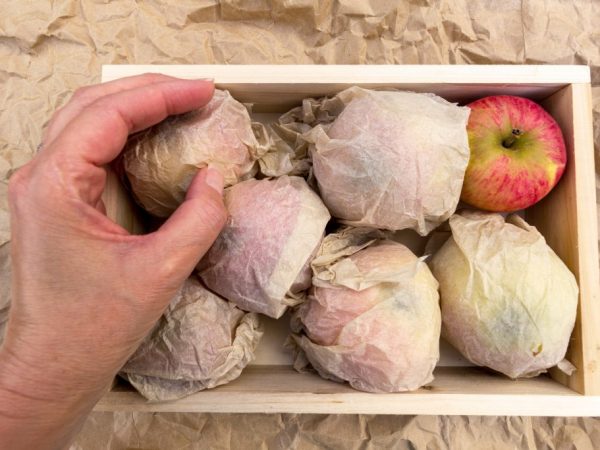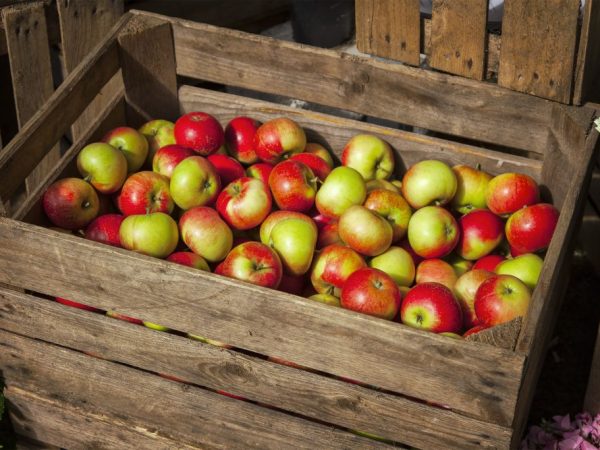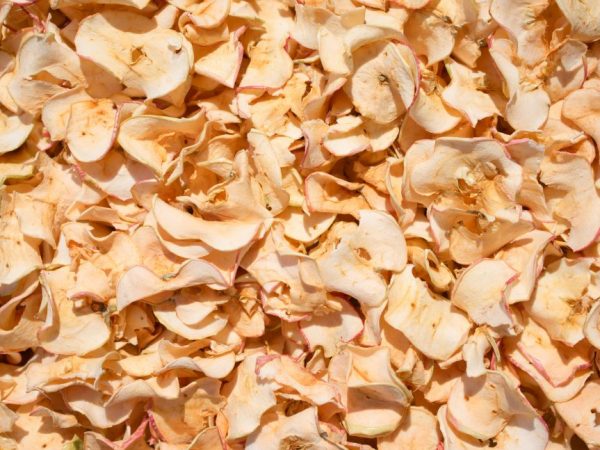Apple storage rules
The fruits are suitable for long-term storage if they are placed under certain conditions. The choice of variety also affects keeping quality. Storing apples is not an easy process: you need to know the basic rules so as not to lose your harvest.

Apple storage rules
Variety selection
There are autumn apple trees, the fruits of which retain their marketable and taste qualities until the onset of spring. The peculiarity of these species lies in the low liquid content, which increases resistance to sub-zero temperatures.
The top 3 autumn varieties of apples for long storage are distinguished, which retain their characteristics throughout the winter.
- Antonovka. This variety is unpretentious to care for. When you pick the fruit, be guided by the degree of ripeness. If the apple has good juiciness and aroma, consumer maturity has come. Once removed, the fruit is suitable for consumption and long-term storage. In the winter variety Antonovka, about 30-40 days pass between these stages of maturity. This variety can be stored for 3-4 months and is suitable for transportation over long distances. The apples of this variety have a sour taste with a slight sweetness. The skin is green and the flesh is juicy.
- The Macintosh variety was bred in America. Harvesting is carried out in September, because fruits will not survive night frosts. The apples are tapered and medium in size. The pulp can be either creamy or greenish. Purple stripes appear on the burgundy peel.
- Simirenko. Fruits in the form of a flattened circle. The shade of the peel is herbal. If you pick apples in September, you will enjoy them until June.
Removing fruit from a tree
The shelf life of apples depends on the method of harvest. Remove each fruit by hand, inspecting it for damage. To keep the crop for several months, adhere to certain rules.
- The best time to shoot the fruit is when 10 ripe apples fall. This mode cannot be used if you have grown columnar varieties. In this case, you should be guided by the ripening time. Late varieties are harvested in early October. Summer collection dates are from late August to mid-September.
- Pick the fruit when the weather is dry and calm.
- Do not pluck the stalk, otherwise the shelf life will be shortened by several months. Twist it to pick the apple off the branch.
- Do not wipe the fruit off with a rag or other device. This will break the natural wax layer, which will shorten the shelf life.
- Place the harvested apples in a drawer. Try not to hit them.
- The correct removal of fruits begins from the bottom, you need to move towards the upper branches gradually.
The next stage is the rejection of damaged and low-quality fruits. For this, the fruit is kept in a cool and dark place for a month. After this period, repeat the inspection again.For winter storage, fruits are sent on which the stalks are preserved, there are no dots and broken parts.
Sort the fruits by variety and size. Do not wash or dry them. The presence of wax deposits is a natural remedy against diseases and parasites, which will preserve the quality of products for a long time.
Packaging and handling
It is better to pack apples for storage in paper or a plastic bag. So you protect them from diseases and pests. Boxes of 30 kg are covered with a plastic bag. With the help of such a flooring, the ripening process is slowed down, the amount of evaporated moisture is reduced and the "breathing properties" of apples are improved.
Only varieties such as Jonathan and Simirenko can be stored in plastic wrap. Storing Antonovka in such conditions will lead to early decay. Use a different film thickness for each variety you will store for the winter.
To prevent Antonovka from showing a "tan", she is placed in paper, which is pre-soaked in oil based on vaseline. With its help, all volatile substances that are released by fruits are adsorbed.
For safety and the possibility of transportation over long distances, apples are treated with carbon dioxide or ultraviolet light.
For treatment with carbon dioxide, the fruits are washed so that the substance does not violate their composition. After that, the harvested apples are placed in a plastic bag and several units of carbon dioxide are injected into it. For these purposes, a siphon is used. The hole through which the gas is admitted is immediately sealed so that oxygen does not get inside.
With the help of ultraviolet light, all bacteria, fungi and infections are eliminated. Range of action - 2 m. Put apples in one layer and within 40 minutes. water them with the preparation "BUF 60".
Processing rules
You need to process the fruits of the apple tree with an alcoholic tincture based on propolis. For its preparation, use 30 g of propolis and a bottle of ethyl alcohol. The beekeeping product is placed in the refrigerator for several days, after which it is crushed using a grater or meat grinder.
The propolis will go bad in the freezer, so don't put it there. In the refrigerator, it retains its beneficial properties.
The crushed product is poured with alcohol and infused for 3 days. Each apple is rubbed with tincture. You can also use chemicals to treat apples for the winter. The best option is potassium chloride. Before using it, the fruit must be washed in soapy water.
Thereafter, 50 g of potassium chloride and 10 l of water are mixed. Apples are placed in the solution and kept in it for 10 days. Further actions are to wipe the fruit with a cloth soaked in glycerin.
Storage conditions
If you create the most suitable conditions for fruit, they will be kept fresh until summer. Containers, packaging and disinfectants are prepared in advance, several weeks in advance.
Keeping quality indicators depend on the place, containers and method of laying. You should familiarize yourself in advance with the characteristics of the varieties you have and prepare the necessary conditions for them. If this is not done, during storage (after a few weeks) the apples turn black and become tasteless.
Premises

Apples store well in dry rooms
It is better to store apples in dry semi-basement rooms. For this, glazed balconies or dark storage rooms are suitable. There should be racks in them. When collecting a bountiful harvest, large rooms are allocated, the temperature in which will be in the range of 0-2 ° C.
Before putting the crop, the room is treated with protective substances and disinfected.
Slaked lime is applied over the entire surface of the walls, which will protect the warehouse from bacteria and viruses. To prepare the solution, use 2 kg of lime and 10 liters of warm water.
All surfaces (including shelves, floors and drawers) are treated with copper sulfate. To prepare the solution, 400 g of ferrous sulfate and 6 liters of warm water are used.Processing is carried out using a soft long-bristled assembly brush.
Equipment and containers
When choosing equipment and containers for storing crops, discard any synthetic materials. They are not able to protect the culture from infection by bacteria or fungi. The containers should be made of non-toxic materials such as wood, cardboard, dense vines.
The main requirement for boxes and bags is strength. To keep them sterile, they are treated with antifungal drugs. It is better to use a solution of potassium permanganate (3 tablespoons per 3 liters of water). The prepared preparation is poured over containers and racks, and then thoroughly dried.
Copper sulfate is used (100 g per 5 L of water). The container is washed with this drug and waited for some time so that it can dry.
Apples should not be stored at high temperatures. They promote the production of ethylene in the fruit, which leads to spoilage. The optimum temperature range is from minus 5 to plus 4 ° С. If this figure is lower, it will lead to aging of the fruit and deterioration of their presentation.
Humidity is an equally important parameter. To regulate it, a hygrometer is installed in the room. Apples store well at 70-90% humidity.
In the ground
Many people store apples in basements or closets in winter. Not everyone knows that land is also suitable for these purposes. The collected fruits are placed in a plastic bag (5-6 kg are stored in such bags). You can put packages in the ground after it has cooled to a minimum temperature of 5-9 ° C.
They are laid in holes up to 50 cm deep. So that the rodents do not eat the fruits, the holes are covered with spruce branches.
In winter, it is difficult to find a fruit storage if a dense layer of snow has fallen. To avoid this problem and find the fruit storage, dig in a thick stick next to it. She should look out from under the snow. For aesthetics, a colored fabric is tied to the stick, which will flutter like a flag.
In the apartment
You can store apples in an apartment using special thermal boxes. If it is not possible to buy them, it is not difficult to build them with your own hands. With the help of such a box, you will save fruit, even if the balcony is not glazed.
To create such a container, you will need 2 cardboard boxes, polystyrene (5 cm wide), insulation (sawdust, foam remains, fabric or polyurethane foam).
To keep fruits fresh in an apartment or house, choose boxes of different sizes, so that after placing the smaller one in the larger one, a distance of 10 cm remains between their walls. It is filled with insulation.
The harvested foam is laid out on the bottom of a small box, and on top of it are the collected fruits. Seal the smaller one with duct tape and cover it with styrofoam. After closing the large container, cover it with a cotton blanket.
Storing cuttings
There are 5 ways to store cuttings used for grafting.
- Outside. Remove weeds and snow from a small area of the soil. You need a hole 20 cm deep. Put the cuttings hidden in a plastic bag inside. Bury the hole with a pointer (stick, metal rod, etc.) next to it.
- In the fridge. The cuttings are kept in moist bags, and after that it is better to put them in cardboard. The bundles are wrapped in a plastic bag and placed in refrigerators.
- In the substrate. Place the cuttings in sand, sawdust, or peat. The substrate is pre-moistened. Cuttings are buried in it and stored at above-zero temperatures. All of these components must be loose in order to ensure high-quality air exchange.
- In the basement. Place the bundles vertically on the shelves and huddle them with sawdust. Spray the substrate every week to keep it moist at all times.
- On the balcony or in the hallway. The graft is wrapped in a plastic bag and hung in the storage area. Inspect the cuttings regularly. It is important that no slices grow on them.
Storage of dried fruits

Dried fruits take up little space
You can store apples in the form of dried fruits at home in any container: cardboard boxes, baskets, glassware or wooden boxes. At the bottom of the container, wrapping paper is laid, on top of which dried fruits are placed.
After that, they are covered with another layer of paper. So that in the room where the drying will be stored, the humidity level is in the range of 50-60%, salt is placed next to the container. It will absorb excess moisture.
Some people prefer cellophane bags. In them, dried fruits will quickly deteriorate. In just 4-5 weeks, they will fog up and mold will appear on their surface. If you leave a dryer that needs a long storage on the windowsill, keep it in glass jars.
The disadvantage of this method is the rapid darkening of dried fruits under the influence of the sun. For long-term storage of drying, dark rooms are suitable. You can keep dried fruits not only in an apple storage, but also in a vacuum. For this, special bags and vacuum equipment are used.
If you want to store dried fruits for a short time, it is enough to put them in vegetable or food containers.
Tips from experienced summer residents
Gardeners who have been involved in the cultivation and storage of food products in the country for a long time have developed some recommendations that help to improve the shelf life and select high-quality fruits.
- Bulk materials are used for storage. Their moisture content should be within 5%. If you exceed it, the fruits become insipid.
- Do not cover the crop with hay or straw. This will provoke the development of a musty smell.
- So that the boxes do not touch, they create cardboard partitions between them with their own hands. For greater reliability, they are laid out in the form of a cross between the fruits.
- To keep the apples in the ground for the winter, an old thread is tied to a bag or paper roll. When you feel like eating delicious apples, pull the rope so that the bag is off the ground.
- In the fall, a week before harvesting, plantings stop watering. The drier the fruits, the longer their shelf life.
- Large-scale storage of fruits is carried out on industrial piles, and not at home. These storage areas have more space and the apples are evenly distributed.

